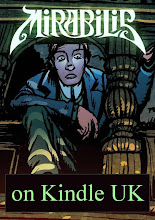 The most effective threats are the ones you set up in the course of your story. That’s why, if you’re going to have your characters menaced by a gun, you should ideally show your audience what the gun can do. Yes, they know that guns can smash vases and blow limbs off. But audiences tend to treat a story universe as an independent microcosm. Which is reasonable enough, as in some story universes (Road Runner) you can get blown up by dynamite and just end up with singed eyebrows.
The most effective threats are the ones you set up in the course of your story. That’s why, if you’re going to have your characters menaced by a gun, you should ideally show your audience what the gun can do. Yes, they know that guns can smash vases and blow limbs off. But audiences tend to treat a story universe as an independent microcosm. Which is reasonable enough, as in some story universes (Road Runner) you can get blown up by dynamite and just end up with singed eyebrows.So you need to show them what the rules of your story universe are. They will accept these rules very readily, by the way. Audiences are actually hungry to find out the rules you’re using.
Suppose you have a bunch of characters enter a very spooky place, but they have a talisman or a protector with them. Spooky as the place is, they are safe as long as they have the talisman and don’t do anything dumb. If you set it up properly, you only have to have the characters lose the talisman and suddenly your audience will be in a real panic. They’ll believe there’s a credible threat in the haunted house or whatever it is because, with that talisman, you set up the rules necessary to achieve suspension of disbelief.
More accurately, you didn’t suspend their disbelief at all. You actively engaged their willingness to believe.
In case this all seems a tad abstract, consider a bunch of little furry-footed chaps going through a really ancient, dark, eerie, goblin-infested cavern complex. But it’s okay because they have the world’s most powerful wizard with them. Except then they come up against a really nasty monster and the wizard deals with it but he falls down a bottomless chasm. And now they’re alone. In the dark. And suddenly Moria seems like a very dangerous place indeed.























No comments:
Post a Comment